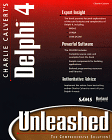by Charlie Calvert and Bob Swart
US/Canada:
 UK/Europe:  |
|
Delphi 4 Unleashed by Charlie Calvert and Bob Swart |
|
 |
Title: Author: Publisher: ISBN: Info: Contents: |
Delphi 4 Unleashed Charlie Calvert SAMS 0-67231-285-9 1152 pages (CD-ROM) |
We had to wait a while for the follow-up of Delphi 2 Unleashed, but there it is: Charlie Calvert's Delphi 4 Unleashed.
This book that consists of almost 1200 pages, provides in-depth coverage of Delphi 4 for intermediate and advanced Delphi programmers.
Delphi 4 Unleashed handles it's topics from a practical point of view and is meant to be read.
Therefore the book is not to be used as tutorial, nor as a reference.
The book is accompanied with a CD-ROM that contains a lot of easy to understand examples, handy components, tools and some chapters that are not in the book itself.
The installation of the examples is quite easy but don't be mislead by the title of the installation program.
You are installing the examples of Delphi 4 Unleashed, not Visual C++ in 21 Days!
The book is split up into the following seven parts: Getting started, Creating Components, Database Programming, COM, Internet, Distributed Programming, and Game Programming.
It starts with a number of general design issues for developing maintainable, object oriented programs.
After that, a description is given of the new features that have been introduced in Delphi 4, including some useful examples that show how to use these new features in practice.
As this part mainly focuses on the new features in Delphi 4, it is most suited for users who are already familiar with Delphi 3 and who want to make optimal use of Delphi 4.
Just like all the other Delphi versions, Delphi 4 is a great environment for developing components.
The second part of Delphi 4 Unleashed describes how to create components.
Although it gives some very detailed examples of how to create components, the information about the real advanced topics like property editors and component editors is not so elaborate.
This makes it less useable for advanced component writers.
On the other hand, it will give enough information for people who start to write their own components.
As most Delphi applications will deal with databases, the third part of this book talks about database programming.
This part mainly focuses on relational databases and in more details on Local Interbase Server and Interbase programming.
That is, the other database programming chapters (Fields and database tools and Flat-file real-world databases) are only available on the CD-ROM.
It's a bit disappointing that not all the chapters mentioned in the index, are in the book itself.
Although the first three parts are interesting, practical and useful, the reason why this book should be on your desk in the first place, is because of the topics in the next parts of this book.
Especially when you are interested in COM, creating distributed applications using DCOM or CORBA, internet programming, or game programming, this book is really unique and absolutely a must.
Part IV starts with a very clear and comprehensive explanation of interfaces and the basics of COM.
After that, topics like COM Automation servers and clients, automating Word, Excel and extending the capabilities of Internet Explorer 4 are discussed and illustrated with good and practical examples.
An excellent chapter, written by Bob Swart, will teach you how to get the very best out of your CGI and ISAPI programs using the Delphi 4 Webbroker technology.
By the way, have you ever seen Java, Delphi and C++ programs work together as close friends? Well, this is exactly what is shown in the Distributed Programming Part.
It shows how Delphi can be used to write distributed applications using CORBA and DCOM, not skipping the tiny little details like for instance the configuration aspects of Windows '95 and Windows ‘98.
The title of the last part is called Game Programming, but actually more than only game programming is covered.
For example, the chapter about VCL Graphic classes, written by Jeff Cottingham, is very useful when writing components that need to show some graphics on the screen.
For those of you who like to experiment with DirectX and DirectSound, this part is a good resource for doing so.
Beware that the DirectX examples need the file vcl35.bpl which is not available on the CD-ROM.
Clearly, these examples use components that have been written in C++ Builder 3 which you may not have installed on your machine.
So, if you want to run these examples, you should first get this file.
It is possible, but certainly not recommended, to copy your vcl40.bpl to vcl35.bpl in order to run the example programs.
Summarized, Delphi 4 Unleashed is a book that is very pleasant to read.
Actually, it's even difficult to stop reading it.
It covers a lot of intermediate and advanced topics that will help to get the best out of Delphi 4 and will certainly open up new horizons.
(Micha Somers)
|
|

| More Book Reviews |

|
|